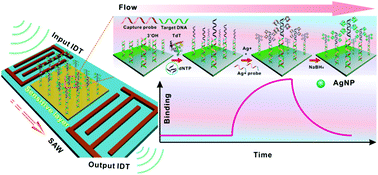A surface acoustic wave biosensor synergizing DNA-mediated in situ silver nanoparticle growth for a highly specific and signal-amplified nucleic acid assay†
Abstract
This work reports a surface acoustic wave (SAW) DNA sensor that synergizes the surface mass effect for signal-amplified and sequence-specific DNA detection in blood serum. By combining an enzyme-mediated DNA extension reaction (both viscoelastic and mass fractions) with the in situ synthesis of silver nanoparticles (mass fraction), a highly sensitive SAW biosensing interface with synergistic mass loading was tailor-engineered. As target DNA hybridized with the surface-confined capture probes, the exposed 3′-OH terminal of the target sequence could be triggered to elongate in the presence of terminal deoxynucleoside transferase (TdT) and deoxy-ribonucleoside triphosphate (dNTP), thereby producing an evident mass effect. Importantly, the extended domain can serve as a template to specifically hybridize with Ag+-binding sequences. In the presence of reducing agents, the accumulated silver ions would nucleate for the in situ synthesis of silver nanoparticles, further enhancing the mass loading. By using this approach, we observed a rapid growth event of silver nanoparticles for signal enhancement, which improved the detection limit (0.8 pM) of the SAW sensor by 3 orders of magnitude as compared to the strategy without signal amplification (at the nanomolar level). The sensor also achieved a high specificity in discriminating even a single-mismatched DNA sequence, and meanwhile could probe the low-abundance DNA molecules directly in human serum with minimal interference. These advantages make the SAW biosensor promising for practical applications, such as monitoring of molecular interactions and disease diagnostics.



 Please wait while we load your content...
Please wait while we load your content...